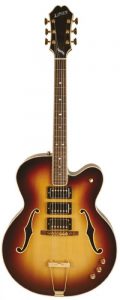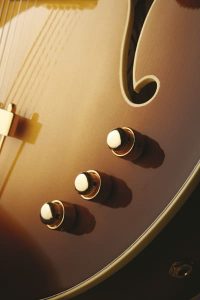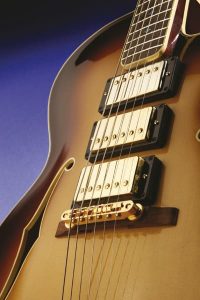Lines Londoner Review
Table of Contents
D’Aquisto had the New Yorker, Guild had the Manhattan, and now British luthier Andrew Lines has the three-pickup Londoner archtop. Rick Batey decides it’s a capital idea. It’s a rare guitar maker who has not dreamed of specialising in archtops, the cream of the luthier’s art, and reaching the heady heights of those hallowed few – almost invariably living in America – who have so many customers waiting in the wings that they’ve effectively closed their Lines Londoner good. For any budding luthier it’s an incredibly difficult pinnacle to reach, as the cost of hand-carved jazz guitars is high, and the market is extremely small.
One new British luthier aiming for those lofty heights is Andrew Lines from Reading in Berkshire. Andrew studied at the Leeds College Of Music, making a 00 flat-top and a Ricky copy on their ‘strings and acoustics’ course. He then went on to London Metropolitan University where he expanded his guitar experiments, eventually gaining his MA with a paper on the effects of an archtop with closeable soundholes. He’s now embarked upon the rocky road of full-time guitar building, and will listen to any requests in terms of design, decoration and hardware, as well as the all-important bespoke stuff like neck shape and dimensions.
LONDONER
The three-pickup ES-5 template is not an obvious target for a British-based guitar maker. It’s a territory branded with the Gibson name, and still served by that company both in original vintage form (from around £5000) and as a reissue (available in the US for under $5000), plus there’s high-value imports such as Peerless too. But Andrew still wanted to make one – and we’re glad he did.
The Londoner has been built around the plans of noted luthier and archtop guru Robert Benedetto; not totally original then, but judicious use of the expertise of others can often help guarantee a success in terms of the finished result. It’s a full-width, medium-depth archtop, 17″ across the body and with 3.25″ deep rims. Back and sides are maple or possibly sycamore with a faint Lines Londonerut pretty flame, while the top is a classy piece of European spruce, wider-grained at the edges than down the centre, though that’s hard to spot thanks to the brown sunburst finish (this sunburst, incidentally, extends around the back of the neck and head as well as the body).
Design
Carving the top and back on an archtop involves a great deal of painstaking work, first with an inside gouge and then with thumb-planes, and generally speaking this maker has achieved some fine, evenly graduated curves. Viewing the back against a hard light there’s a lumpiness towards the binding in a number of areas that usually would be eradicated by working with a large, flexible straight-edged cabinet scraper, and some of the inner black/white/black binding on the top has a squashed appearance and could have been made cleaner. Overall, however, it’s an impressive and well-proportioned guitar. The nitro-cellulose finish is also good, though it’s not perfect where binding meets spruce.
The two-piece maple neck is topped with a 25″ scale rosewood fingerboard carrying 21 nicely-fitted frets, decorated with snowflake pearl position markers and, like the body, edged with single cream binding. Some might prefer a square fingerboard end to the rounded one on this guitar, which perhaps doesn’t quite suit the classic all-American styling, but that’s entirely subjective. The neck is topped off with an extremely pretty elongated headstock, double-bound and carrying the maker’s name in pearl and a pearl-inlaid rosewood trussrod cover that matches the rosewood headstock facing. The tuners are gold stairstep Grovers: they haven’t been fitted quite straight, but their art deco styling suits the guitar nicely. Down at the other end we’ve got a tune-o-matic bridge on a well-fitted floating rosewood base and a nice, plain ‘raised diamond’ trapeze tailpiece, as fitted to budget archtop Gibsons.
Sounds
Acoustically the Londoner is a pleasure to play. Though the top has been left a little thicker than regular spec to add strength and keep feedback at bay. The solid spruce top with its near-parallel bracing produces plenty of volume for a guitar with pickups stuck in the front. The neck is also a fine success: it’s a fairly generous 44.5mm/1.75″ at the nut and the profile is a fair handful, but that makes complicated chord voicings a breeze. Of course, any custom guitar like this can be built to accommodate your preferences. The set-up is also good, with a finely-cut bone nut, perfect neck relief and a action set just right for the heavy nickel roundwound strings.
The pickups, which are housed in custom-fitted black plastic surrounds, are relatively affordable Golden Age humbuckers sourced from the Stewart-Macdonald catalogue. They’re PAF-like but slightly hot, and well-balanced with clear highs, uncluttered mids and firm, warm lows, and certainly would give some boutique names a run for their money. The
Londoner is wired with a stacked tone/volume pot for each of the three pickups, plus a three-way toggle: it’s a simple but adaptable arrangement giving easy access to the warm, jazzy neck pickup, a much softer, mellower sound from the bridge/middle combination, and the brighter, more attacking highs of the bridge alone. Many players will find the central pickup gets in the way, but the sound it offers is very different to a twin-pickup guitar’s middle switch setting. Best of all, the Londoner’s hollow, characterful acoustic sound really does come through.
Verdict On The Lines Londoner
You might imagine that a non-amplified model would be a better yardstick of Andrew’s skills than the Londoner with its three pickups set into the top, but the trio of humbuckers hasn’t dampened the acoustic character of the carved-top Londoner. Generally, non-laminated archtop guitars cost money: lots of it. It’s an area of luthiery removed from the majority of players by cost alone. But one way to lay hands on one without sacrificing the price of a nice used family car is to discover a maker in the early stages of his or her career. Get it wrong, and you’ll have a guitar no-one has ever heard of which may prove difficult to re-sell down the line. Get it right, and you might score an amazing-sounding keeper for little more than the price of a high-end, mass-produced solidbody. The name of Andrew Lines is a new ingredient to throw into this chin-stroking equation. And one thing’s for sure: if you value British craftsmanship and figure the asking price for this Londoner model against the number of hours that must have gone into building it, it’s well worthy of consideration.





Leave a Reply
You must be logged in to post a comment.